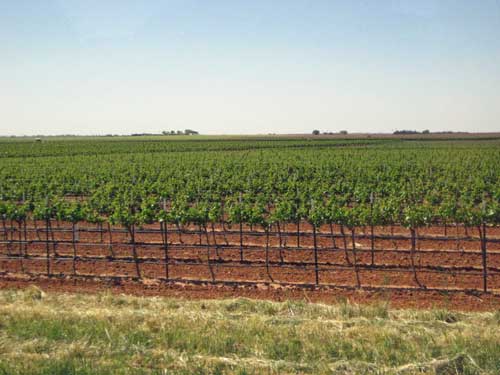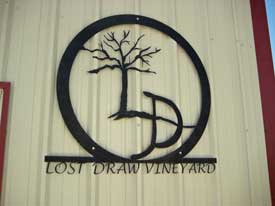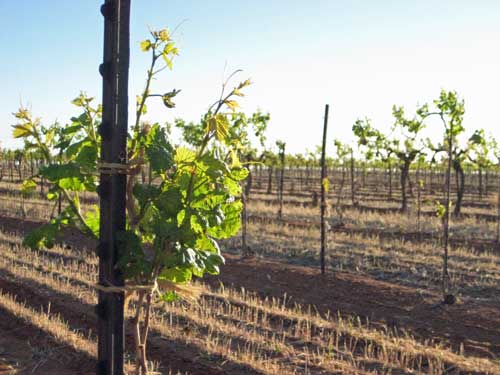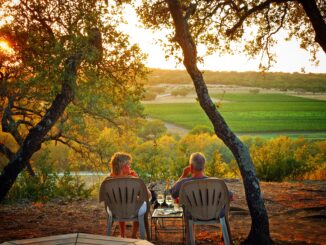
Brownfield, Texas: No Way! Been There and its Green with the Vines of Texas Wine Grapes
We gathered in Brownfield, Texas, Yesterday. What you’ve never heard of it? Never seen it in the Atlas of Wine Regions of the World? Never read about it in the Wine Spectator? Not on the travel agenda of the mainstream wine media. Go figure….
The gathering included two busloads that assembled at the Terry Country Law Enforcement Center in Brownfield to visit Texas wine country, up close and personal. The day was spent roaming where only the deer and the antelope did such a thing and cotton is still supreme. We stopped occasionally to inspect vineyards, about a dozen in all, only a handful of the total that now account for over what was estimated at 700 acres of wine grapes in Terry County.
I can here you now saying, “Wait, where the hell-in Texas are Brownfield and Terry County, anyway? Well, they are both in the wine-producing region known as the Texas High Plains AVA (American Viticultural Area) in far northwest Texas. More specifically, they are about a hour south of Lubbock at about 3300 feet where hot arid days and cool nights combine with the red sandy loam over porous caliche limestone that most wine producing regions would give their eye teeth to own.
We made the rounds. Some on the bus were local winegrowers, but many were wine-curious, some wannabes, but most had serious interest in growing Texas wine grapes as a way to augment their allocation of row crops like cotton, soybeans, peanuts and even melons. At one point, looking out from the bus, there were vines to the horizon. I don’t think I ever had that experience before, at least in Texas. Some vineyards like the Bogar-Cox vineyard were planted long ago with gnarly Cabernet and Chenin Blanc vines going on thirty years now. Some like Reddy Vineyard have grown to over 100 acres with recent plantings.
Worthy of note were the new vineyards, most in only their second, third or forth year, that are just now coming into production for making the good juice badly needed for sought after Texas wines. These are important vineyards as they are helping to erase the Texas wine grape deficit that has arisen due to the rapid growth in the number of Texas wineries across the state and the past few years of nasty weather that has embrittled young spring buds with freezing temperatures, submerged them in seas of rainwater, and pummeled vines nearly to death with hail.

The vineyards that we saw were some of which I was aware such those of Jet Wilmoth, Larry Young, and Andy and Dusty Timmons, but still more that were completely new to me.
Most apparent in the long list of grape varieties expounded by vineyard owners to the tour group was the lack of commonly expected names that we have grown accustomed from our education in wine received from California’s prime wineries. For example, not much new Cabernet Sauvignon appeared to be planted and just about a total absence of Chardonnay. Interestingly, both have made award-winning wines here, some of the medals garnered were in major national and international wine competitions. The problem is that varieties like Chardonnay are difficult to grow, give unsustainably low yields and have short life span. However, present were grape varieties that I have written about previously such as: (White grapes) Vermentino, Viognier, Muscat Canelli, Roussanne, and (Red Grape) Tempranillo, Aglianico, Mourvedre, and Sangiovese. These are grape varieties that are most in tune with Texas terroir (e.g. the soil and climate of Texas).
At the end of the day, courtesy of Cliff Bingham from Bingham Family Vineyards a short piece to the north, I received a taste of a new grape in a wine from Les Constable’s Brushy Creek Vineyards. It was Muscat Giallo made in slightly off-dry and sparkling styles.
With all these new grape varieties, he challenge for Texas going forward is two-fold. One is getting the grapes grow and through the winemaking process and the other is up to the consumers to be aware of these new varietals. They may be packaged as blends of red or white grape that will be likely sold under proprietary names or as single varietal wines under their exotic grape names. Start your Lexicon now by buying a bottle, two or three. Do some tasting of these new wines and find the ones that are to your liking.
The dirt in Brownfield may be brown (actually, more like iron-rich Martian red), but the vineyards up here are green and growing.



“The dirt in Brownfield may be brown (actually, more like iron-rich Martian red), but the vineyards up here are green and growing.”
To Quote Greg Bruni in a recent interview, “Texas wine, Its like growing grapes on mars!”
I agree totally. Listened to a session at the Newsom Grape Day on Friday that indicated that the beneficial impact of red dirt on plants like grape vines comes from the reflection of red wavelength light on buds and leaves. It promotes fruitfulness of the vines per Ed Hellman at Texas Tech’s Viticulture Program.
Wow! This is hard to believe. I lived in Brownfield for 2 years – 1985 and 1986 and it was a dry county! And now they are planting grapes and making wine! What fabulous progress.
I have had the privilege of drinking some of the Sisters Creek Muscat Canelli wine form there, and I am not normally a wine drinker, but I do love this wine. I recommend it to people every chance I get.
I just finished a glass of sangiovese from Val Verde Winery and I must say I am very impressed. Who knew Texas could produce such a great grape / wine. I found out as I was tasting the Val Verde wines that most of the grapes that Val Verde Winery uses comes from the Brownfield area. Kudos to Brownfield and Texas for their work on growing and producing a great grape!
Where in this does it mention the original founders of the longest lasting vineyard in Terry County. This would be Bobby and Patsy Young. THEY planted their vineyard in 1987. Somehow the Newsom’s and the Timmon’s are always praised for their crops.